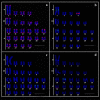Molecular cytogenetic analysis and the establishment of a cell culture in the fish species Hollandichthys multifasciatus (Eigenmann & Norris, 1900) (Characiformes, Characidae)
- PMID: 33877256
- PMCID: PMC8056886
- DOI: 10.1590/1678-4685-GMB-2020-0260
Molecular cytogenetic analysis and the establishment of a cell culture in the fish species Hollandichthys multifasciatus (Eigenmann & Norris, 1900) (Characiformes, Characidae)
Abstract
Hollandichthys is a fish genus of the family Characidae that was until recently considered to be monotypic, with cytogenetic, morphological, and molecular data being restricted to a few local populations. In the present study, the karyotype of a population of Hollandichthys multifasciatus was analyzed using classical and molecular cytogenetic approaches for the investigation of potential markers that could provide new perspectives on the cytotaxonomy. H. multifasciatus presented a diploid number of 2n=50 chromosomes and a karyotype formula of 8m+10sm+32st. A single pair of chromosomes presented Ag-NORs signals, which coincided with the 18S rDNA sites visualized by FISH, whilst the 5S rDNA sequences were mapped in two chromosome pairs. The distribution of the U snRNA genes was mapped on the Hollandichthys chromosomes for the first time, with the probes revealing the presence of the U1 snDNA on the chromosomes of pair 20, U2 on pairs 6 and 19, U4 on pair 16, and U6 on the chromosomes of pair 11. The results of the present study indicated karyotypic differences in comparison with the other populations of H. multifasciatus studied previously, reinforcing the need for further research to identify isolated populations or the potential existence of cryptic Hollandichthys species.
Conflict of interest statement
Figures



Similar articles
-
Comparative cytogenetics among populations of Hollandichthys multifasciatus (Teleostei: Characidae).Zoolog Sci. 2013 Feb;30(2):105-9. doi: 10.2108/zsj.30.105. Zoolog Sci. 2013. PMID: 23387844
-
Chromosomal mapping of repetitive sequences in Hyphessobrycon eques (Characiformes, Characidae): a special case of the spreading of 5S rDNA clusters in a genome.Genetica. 2020 Feb;148(1):25-32. doi: 10.1007/s10709-020-00086-3. Epub 2020 Jan 29. Genetica. 2020. PMID: 31997050
-
Highly Similar Morphologies Between Chromosomes Bearing U2 snRNA Gene Clusters in the Group Astyanax Baird and Girard, 1854 (Characiformes, Characidae): An Evolutionary Approach in Species with 2n = 36, 46, 48, and 50.Zebrafish. 2016 Dec;13(6):565-570. doi: 10.1089/zeb.2016.1292. Epub 2016 Jun 22. Zebrafish. 2016. PMID: 27332923
-
Cytogenetic comparison between two allopatric populations of Astyanax altiparanae Garutti et Britski, 2000 (Teleostei, Characidae), with emphasis on the localization of 18S and 5S rDNA.Comp Cytogenet. 2011 Aug 24;5(3):237-46. doi: 10.3897/CompCytogen.v5i3.1235. eCollection 2011. Comp Cytogenet. 2011. PMID: 24260632 Free PMC article.
-
Cytogenetic analysis in three Bryconamericus species (Characiformes, Characidae): first description of the 5S rDNA-bearing chromosome pairs in the genus.Mol Cytogenet. 2013 Apr 1;6(1):13. doi: 10.1186/1755-8166-6-13. Mol Cytogenet. 2013. PMID: 23547656 Free PMC article.
Cited by
-
Small Body, Large Chromosomes: Centric Fusions Shaped the Karyotype of the Amazonian Miniature Fish Nannostomus anduzei (Characiformes, Lebiasinidae).Genes (Basel). 2023 Jan 11;14(1):192. doi: 10.3390/genes14010192. Genes (Basel). 2023. PMID: 36672933 Free PMC article.
-
Occurrence of Sex Chromosomes in Fish of the Genus Ancistrus with a New Description of Multiple Sex Chromosomes in the Ecuadorian Endemic Ancistrus clementinae (Loricariidae).Genes (Basel). 2023 Jan 24;14(2):306. doi: 10.3390/genes14020306. Genes (Basel). 2023. PMID: 36833233 Free PMC article.
-
Primary Cell Culture as a Model System for Evolutionary Molecular Physiology.Int J Mol Sci. 2024 Jul 19;25(14):7905. doi: 10.3390/ijms25147905. Int J Mol Sci. 2024. PMID: 39063147 Free PMC article. Review.
References
-
- Amemiya CT, John WB, John RG. A cell culture technique for chromosome reparation in Cyprinid fishes. Copeia. 1984;1984:232–235.
-
- Amemiya CT, Gold JR. Chromosomal NORs as taxonomic and systematic characters in north american cyprinid fishes. Genetica. 1998;76:81–90.
-
- Ashley T, Ward DC. A ‘hot spot’ of recombination coincides with an interstitial telomeric sequence in Armenian hamster. Cytogenet Cell Genet. 1993;62:169–171. - PubMed
-
- Balen RE, Noleto RB, Vicari MR, Artoni RF, Cestari MM. Comparative cytogenetics among populations of Hollandichthys multifasciatus (Teleostei: Characidae) Zool Sci. 2013;30:105–109. - PubMed
-
- Barman AS, Singh M, Singh RK, Lal KK. Evidence of birth-and-death evolution of 5S rRNA gene in Channa species (Teleostei, Perciformes) Genetica. 2016;144:723–732. - PubMed
Internet Resources
-
- Fricke R, Eschmeyer WN, Fong JD. Species by Family/Subfamily. 2020. [07 de February 2020]. Species by Family/Subfamily, http://researcharchive.calacademy.org/research/ichthyology/catalog/Speci....
LinkOut - more resources
Full Text Sources
Other Literature Sources

